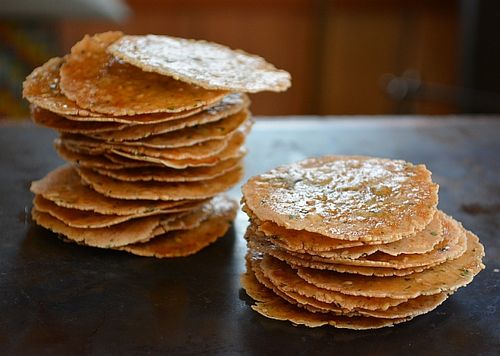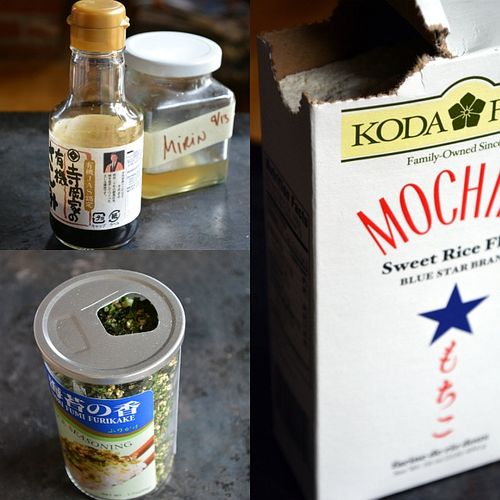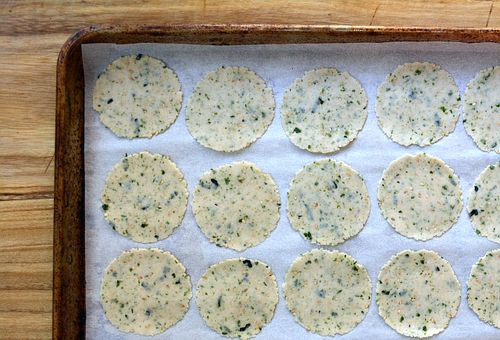The first time my family visited San Francisco in the early 1980s, we lingered in Golden Gate park’s Japanese tea garden. It was beautiful, and my father loved formal Asian gardens. One of my sisters bought a bag of Japanese rice crackers, and upon tasting one, I thought they were the best. Our family loves crackers so we divided the Japanese ones up so that each person received his/her fair share.
Crackers play a big role in Viet eating. They include toasted rounds of Vietnamese banh da nuong made of rice and deep-fried shrimp chips. You can snack on them and use them to scoop up food like a chip. The Japanese crackers were a novelty to us when we ‘discovered’ them. Years later my sister Tasha married a Japanese American man, and one of the benefits was regularly getting a select treasure trove of Japanese rice crackers.
Don’t get me started on non-Asian crackers because I enjoy them too. In my twenties, I became too familiar with the grocery store cracker aisle. Then I stopped buying them because I realized that I didn’t feel good from eating the boxed crackers, which often have a lot of weird ingredients. Commercially made “Vegetable Thins” and “Cheez-It” crackers don’t agree with me.
I mostly eat rice crackers these days, buying small baked ones to munch on or enjoy with stuff like Sriracha pimento cheese and raw tuna tartare. I didn’t think of making them, until I read Ivy Manning’s book, Crackers & Dips: More than 50 Handmade Snacks. Ivy is an established food writer and cookbook author with professional cooking experience. You may have seen her byline in publications like Cooking Light magazine.
Her latest book is adorable and filled with a bunch of recipes for sensational crackers and dips. I visited Ivy in 2012 during my Asian Tofu book tour stop in Portland, Oregon. She kindly let me use her home kitchen to prepare a tofu snack for a book talk. While I was there, she baked about five kinds of crackers. I was in heaven. Ivy told me about a cracker recipe inspired by Japanese senbei crackers. Traditional ones are a little tricky to make and I was curious to try hers out.
Ivy’s recipe was easy and fun. She used Asian pantry ingredients and all I had to get was a new container of furikake mixture of seaweed and sesame seeds. (My health food market had it.) I tried the recipe with the sweet rice flour, as she suggested, and regular rice flour. Both worked well, with the regular rice flour baking up to resemble Pringle’s potato chips; they are a tad chalky tasting compared to the sweet rice flour. The dough came together in minutes so it was fun to tinker with it to yield the recipe below. The key is to press the dough super thin, lest they bake up like poker chips.
Handmade crackers are charming. These taste great and I’m quite impressed with Ivy and myself. Try the recipe out. I have an extra copy of Crackers & Dips for a giveaway later this week. Stay tuned!
Recipe
Japanese-Style Furikake Rice Crackers
Yield: 40 crackers
Ingredients:
- ¾ teaspoon plus ½ teaspoon soy sauce or wheat-free tamari
- 2 teaspoons mirin, storebought or homemade
- About ¼ teaspoon fine sea salt
- ¾ cup (120 g) Japanese Mochiko sweet rice flour (Blue Star brand) or regular rice flour (any Thai brand)
- ⅓ cup (40 g) cooked white rice
- 2 tablespoons canola oil
- ¼ cup (60 ml) water
- 2 tablespoons furikake
Instructions:
- Position a rack in the middle of the oven and preheat to 375F (190C / gas mark 5). Line two baking sheets with parchment paper. Combine ¾ teaspoon soy sauce and mirin in a small bowl; taste and add pinches of sea salt for sweet savory flavor. Split a small zip-top plastic freezer bag down the side seams, keeping it connected at the bottom seam. Set aside.
- To make the dough, put the rice flour, rice, ¼ teaspoon sea salt, ½ teaspoon tamari (or soy sauce) and oil in a food processor. Run until finely ground. Remove the plunger from the feed tube, then run the machine, slowly adding the water through the feed tube to form a crumbly mixture.
- Transfer to a bowl and add the furikake. Knead to combine into a slightly oily dough. It will feel a bit crumbly but firmly press it together. Divide into 4 equal pieces.
- Working with a piece of dough at a time, roll it into a 5 or 6 inch log. Cut it crosswise into 10 pieces (think like you would with dumpling dough!). Roll each piece of dough into a small ball.
- Place a dough ball between the sheets of the plastic bag, then press with a tortilla press, bottom of a flat-bottomed dish or juice glass. Aim for super thin round about 2 ½ inches (6 cm) wide. If the round tears, roll it up and press again. Carefully peel the dough round off the plastic and set on the prepared baking sheet. Press the remaining balls of dough, placing them about ¼ inch apart from one another. When done, repeat with the other pieces of dough.
- Bake the crackers, one baking sheet at a time, for about 8 minutes, until dry at the edges. Flip the crackers with a metal spatula and/or your fingers. Bake again for about 8 minutes, until the crackers start to brown; they’ll sizzle.
- Remove from oven, cool for a minute, then brush the tops of the crackers with the tamari-mirin mixture. Return to the oven and bake a final time until glazed looking and lightly browned, 2 to 3 minutes. Monitor carefully or the glaze will burn and become bitter.
- Cool completely on a wire rack before eating. They’ll crisp up as they rest. Store in an airtight container for up to 1 week.
 Adapted from Ivy Manning’s Crackers: More than 50 Handmade Snacks (Chronicle Books, 2013)
Adapted from Ivy Manning’s Crackers: More than 50 Handmade Snacks (Chronicle Books, 2013)
Related posts:
- Homemade mirin
- Furikake caramel popcorn (a great great great snack to make with that furikake)
- Sriracha pimento cheese
- Spicy tuna tartare with Viet herbs




















[email protected] says
You need to use a gluten-free soy sauce for the crackers to be truly gluten-free.
Andrea Nguyen says
Definitely. A wheat-free Yamasa brand tamari is what I used for the ones pictured here. I also made some with fancy shoyu (in the little bottle in the photo with the homemade photo).
The furikake I bought was gluten-free. Some furikake contain wheat derivatives. I trust that folks who are wheat sensitive know what to do.
candice says
Yum! I love furikake crackers. I'm going to bookmark this. Thanks for sharing, Andrea.
Andrea Nguyen says
You're welcome, Candice. My furikake had a lot of sesame seeds. Next time, I may just buy ground up seaweed and mix it with ichimi togarashi.
Rachel says
What would happen if you added a bit of baking powder to the mix? Would they puff up a little and become more like the arare you buy in the store?
Andrea Nguyen says
I don't know, Rachel. The arare in the store is made with freshly ground or pounded mochi rice, I think, which would explain why they puff nicely. Knowing Ivy, I bet she tried adding leavening to this mixture. But if you're wondering, try it out and see what happens. It wouldn't hurt.
Dyan says
I wondered if you knew how to make the biscuits they sell in markets throughout Japan? They have various additions like peas and peanuts and have a flavour like cardamom. I saw them being made in Kyoto. The mix was very liquid and the biscuit was poured onto a hot grill. I’m keen to make these. Any suggestions?
Andrea Nguyen says
Gosh, I'm not sure on that one. It sounds like a batter was used. Sorry, I've not come across such a recipe as what you've described. Sometimes, certain things are best left to the pros. Do you have a name for them? If you do, jump over to ask cookbook author and Japanese food expert (plus a friend of mine), Elizabeth Andoh. Her amazing website and resources are at http://www.tasteofculture.com/
Mitalee says
Hi Andrea ,
I tired this receipe today. One basic question : I am using Microwave for baking it. When you say it " To bake" does it mean on convection mode? Or microwave mode?
My crackers were perfectly hard from outside but inside it was bit gummy.l
Andrea Nguyen says
The instructions are for a regular oven so in regular baking mode or convection mode. The microwave would do something else to the crackers and I guess now you and I both know. Thanks for the dispatch!